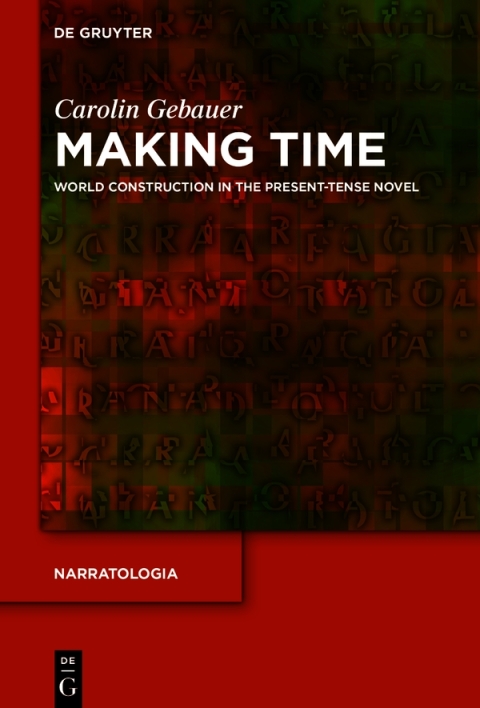Description
Efnisyfirlit
- Acknowledgments
- List of Figures and Tables
- Figures
- Tables
- Abbreviations of Titles
- 1 Introduction
- 1.1 Present-Tense Usage in Contemporary Narrative Fiction: A New Debate
- 1.2 Theoretical Preliminaries: The Relation between Present-Tense Narration, Time, and Narrative Worldmaking
- 1.3 Beyond the ‘Grammatical’ Fallacy: Key Arguments and Structure of this Book
- Part I Mapping the Research Field on Present-Tense Narration
- 2 Linguistic, Narratological, and Philosophical Considerations on Tense Usage in Narrative Fiction
- 2.1 The Beginnings of a Theoretical Engagement with Fictional Tense Usage: Käte Hamburger’s Thoughts on the Epic Preterite and Their Consequences for Present-Tense Narration
- 2.2 Diachronic Approaches to Present-Tense Narration: The Evolution of the Present Tense as a Genuine Tense of Narration
- 2.3 Synchronic Approaches to Present-Tense Narration: Investigating the Present Tense from an Interdisciplinary Perspective
- Part II A Narratological Model of Present-Tense Usage in Narrative Fiction
- 3 The ‘Grammatical’ Fallacy, or: Why We Need a Descriptive and Analytical Model of Present-Tense Narration
- 4 The Formal-Structural Dimension of Fictional (Present-)Tense Usage: Textual Distribution and Narrative Orchestration
- 4.1 Formal Criteria for Determining the Distribution of Tense Usage in Narrative Fiction: Variety, Scope, and Prominence
- 4.2 Structural Criteria for Analyzing the Orchestration of Tense Usage in Narrative Fiction: Tense Alternation and Foregrounding of Tense
- 5 The Functional Dimension of Fictional Present-Tense Usage: Uses and Functions of Present-Tense Narration
- 5.1 Encoding the Here-and-Now: Present-Tense Narration and Narrative Worldmaking
- 5.2 The Referential Function
- 5.3 The Immersive Function
- 5.4 The Metareferential Function
- 5.5 The Communicative Function
- 5.6 The Synchronizing Function
- 5.7 The Thematic Function
- 5.8 The Rhetorical Function
- 5.9 The Transmodal Function
- 5.10 Modeling the Process of Worldmaking in Present-Tense Narration, or: The Functional Matrix of Fictional Present-Tense Usage
- 6 The Syntactic Dimension of Fictional Present-Tense Usage: Correlations between (Different Kinds of) Present-Tense Narration and Other Narrative Strategies and/or Phenomena
- 6.1 The Multifunctionality of Fictional Present-Tense Usage
- 6.2 The Functional Interplay of Present-Tense Narration with Other Narrative Strategies and/or Phenomena
- Part III Uses and Functions of Present-Tense Narration in Contemporary Narrative Fiction
- 7 Narrative of Reformation: The Revision of History and Narrative Form in Hilary Mantel’s Wolf Hall (2003) and Bring Up the Bodies (2012)
- 7.1 The Revisionist Character of Mantel’s Tudor Narratives: Turning a Historical Villain into a Fictional Hero
- 7.2 Creating a Likeable Character: The Empathic Impact of Mantel’s Referential Use of the Fictional Present
- 7.3 Foresight Instead of Hindsight: Representing History as Future Turning Points
- 7.4 Witnessing History in the Making: Spatial Non-Contextualization, Associative Storytelling, and the Immersive Potential of Mantel’s Present-Tense Usage
- 8 Narrative of Punishment: Experientiality, Immersion, and the Representation of Narrative Space in Margaret Atwood’s Oryx and Crake (2003)
- 8.1 Encountering Unknown Worlds to Come: Anthropocene Fiction as a Model for Reality
- 8.2 Before and After the Apocalypse: Temporalizing Atwood’s Heterogeneous Use of Fictional Tense
- 8.3 Posthuman Space, Episodic Plot Structure, and the Thematic and Descriptive Functions of the Fictional Present
- 8.4 Dynamic Descriptions and the Immersive Function of Present-Tense Narration
- 9 Narrative of Reminiscence: Intercultural Understanding and Narrative Empathy in Nadeem Aslam’s Maps for Lost Lovers (2004)
- 9.1 Nurturing the Intercultural Mind: The Empathic Potential of Intercultural Narratives
- 9.2 Addressing an Out-Group Readership: Tense-Switching and the Communicative Situation of Aslam’s Novel
- 9.3 Foregrounding Narrative Space: The Topochronic Dynamics of Aslam’s Narrative
- 9.4 Narrative Immediacy and Hyper-Analepsis as Means of Strategic Empathizing
- 10 Narrative of Deception: Narrative Progression, Suspense, and Surprise in Don Winslow’s The Power of the Dog (2005)
- 10.1 About Drug Lords, DEA Agents, and Webs of Deception
- 10.2 Spatial Disorientation, Narrative Sequentiality, and Temporal Immersion: Winslow’s Chronotopic Present-Tense Narration
- 10.3 Leading the Reader Up the Garden Path: Covert Omniscient Narration and Orchestrated Multiperspectivity
- 10.4 Creating Suspense and Surprise: The Narrative Dynamics of the Thriller
- 11 Narrative of Emergence: Metanarration, Intertextuality, and the Disclosure of Worldmaking in Ian McEwan’s Nutshell (2016)
- 11.1 First Contact with a Narrating Fetus
- 11.2 Framing the Narrative Scenario: Metareferential Present-Tense Narration as a Means to Naturalize McEwan’s Antimimetic Narrator
- 11.3 Delayed Exposition, Emerging Plot, and Narratorial Inferences: Combining Synchronizing, Thematic, and Descriptive Uses of the Fictional Present
- 11.4 The Play with Generic Conventions: McEwan’s Intertextual References to the Detective Novel
- 12 Narrative of Emancipation: Character-Centered Illusion, Cognitive Dissonance, and Narrative Unreliability in Emma Donoghue’s Room (2010)
- 12.1 ‘Strange’ Narrators, Cognitive Dissonance, and Character-Centered Illusion
- 12.2 Exploring “Room”: Jack’s Strange Perception of the World and the Dominant Use of Thematic Present-Tense Narration
- 12.3 Taking Jack’s Perspective: Immersive Present-Tense Usage, Unreliable Narration, and Suspense
- 12.4 Adapting to “Outer Space”: Descriptions, Explanations, and the Transmodal Function of the Fictional Present
- 13 Narrative of Life: Orality, Narrative Authority, and the (Broken) Illusion of Immediacy in Irvine Welsh’s Skagboys (2012) and Dead Men’s Trousers (2018)
- 13.1 Narrative Expansion and the Representation of Time: Some Preliminary Thoughts on the Temporal Structure of Prequels, Coquels, and Sequels
- 13.2 A Different Kind of Narrative Illusion: The Communicative Function of Present-Tense Narration, Small Stories, and Narrative (In)Coherence
- 13.3 Oral Storytelling vs. Written Narrative: The Nexus between Fictional Tense Usage and Narrative Authority
- 13.4 The Broken Illusion of Narrative Immediacy: Why the Concept of ‘Telling to the Moment’ Is Not Always Successful
- 14 Concluding Remarks, or: The Future of Research on Present-Tense Narration
- 14.1 What This Book Has to Offer. . .
- 14.2 . . . What Else Could Be in Store. . .
- 14.3 . . . and What the Present-Tense Novel Can Tell Us about Contemporary Culture
- Works Cited
- Primary Sources
- Secondary Sources
- Author Index
- Subject Index





